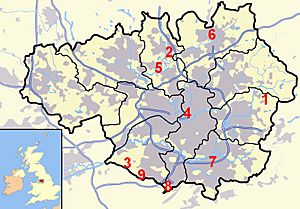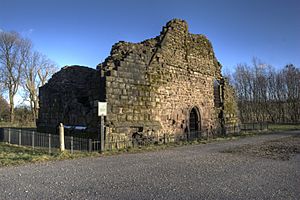List of castles in Greater Manchester facts for kids

- Buckton Castle
- Bury Castle
- Dunham Castle
- Manchester Castle
- Radcliffe Tower
- Rochdale Castle
- Stockport Castle
- Ullerwood Castle
- Watch Hill Castle
Greater Manchester, a large area in North West England, is home to nine historic castles. These aren't all the same type of castle. Some are motte-and-bailey castles, which were popular after the Norman Conquest. A motte-and-bailey castle has two main parts: a "motte" (a big dirt mound with a wooden fence or stone tower on top) and a "bailey" (a fenced area next to the mound).
Other castles here include fortified manor houses, which were strong homes, an enclosure castle (a castle with a stone wall around it), and possibly a shell keep (a motte with a stone wall instead of a wooden fence). Four of these castles are very important historical sites. They are called scheduled monuments. This means they are protected by law because they are "nationally important" archaeological sites or old buildings.
Castles were more than just military forts. They showed who was in charge of an area. They were also symbols of power and wealth. Some castles even became busy centers for trade and managing local lands.
The oldest castles in Greater Manchester are Dunham Castle and Watch Hill Castle in Trafford, Ullerwood Castle in Manchester, and Stockport Castle in Stockport. These castles were first mentioned in 1173. They belonged to powerful lords who had rebelled against King Henry II. Many of these early castles were motte-and-bailey types. This was because they could be built quickly and easily.
Even later, new castles were built in the area. The last ones were two fortified manor houses near Bury. These were built more for comfort than for fighting. Bury Castle and Radcliffe Tower were built in the 13th century. They likely served as the main buildings for the local estates they managed.
Contents
Castles in Greater Manchester
Here is a list of the castles found in Greater Manchester. Each one has its own unique story and features.
Buckton Castle
Buckton Castle is located on Buckton Hill, near Carrbrook. It sits high up, looking over the Tame Valley. This spot might have helped the castle guard the valley below. It was probably built by the Earls of Chester in the 1100s. By 1360, it was already in ruins.
This castle was an enclosure castle. It had a strong stone wall around it. A ditch about 10 meters (33 feet) wide and 6 meters (20 feet) deep surrounded the site. The whole area covers about 730 square meters (0.18 acres). Treasure hunters in the 1700s damaged the site. It is also close to a quarry. Buckton Castle is a protected scheduled monument.
Bury Castle
Bury Castle is in the center of modern Bury. It sits on a slope overlooking the River Irwell. This castle was a fortified manor house, built from stone for Sir Thomas Pilkington in 1469. It might have replaced an older house that had a moat (a water-filled ditch) around it.
When archaeologists dug up the remains, they found foundation walls that were 180 meters (590 feet) by 82 meters (269 feet). They also found a keep or tower that was 25 meters (82 feet) by 19 meters (62 feet). Bury Castle was torn down after the Wars of the Roses. This happened because Thomas Pilkington lost his land. Today, the excavated remains are on public display in Castle Square. Bury Castle is a protected scheduled monument.
Dunham Castle
Dunham Castle is located in Dunham Massey. It was first mentioned in 1173 and belonged to a lord named Hamon de Massey. The castle was still standing in 1323 but fell into disuse by 1362.
The castle's motte (mound) is about 24 meters (79 feet) across and still stands about 2 meters (7 feet) high. The site is surrounded by a moat, which is now a pretty ornamental lake. It used to be a scheduled monument, but it was later removed from the list. This was because it might be a natural sand hill, not something built by people.
Manchester Castle
Manchester Castle was likely built on a high spot where the rivers Irk and Irwell meet. This is near Manchester Cathedral today, underneath where Chetham's School of Music now stands. This location would have been on the edge of the medieval town of Manchester.
It might have started as a ringwork castle, which is an early type of castle with a circular earthwork. It was first recorded in 1184. In 1215, it was held by the baron of Manchester, Thomas Gresle. Later, in 1243, Robert de Furch held it. Digs have found three rings of ditches around where the castle probably stood. Manchester Castle was a fortified manor house.
Radcliffe Tower
Radcliffe Tower is on Church Street East in Bury. It is all that is left of a medieval fortified manor house. This house was built in 1403 from stone and had two towers and a moat. The main house was taken down in the 1800s. Only one tower remains today.
This tower is a very important historic building, listed as a Grade I listed building. It is also a scheduled monument. The tower measures about 9.6 meters (31 feet) by 17 meters (56 feet) and is still 6.1 meters (20 feet) high. Before it was restored, it was even used as a pig sty!
Rochdale Castle
Rochdale Castle is a motte-and-bailey castle. It was built early after the Norman Conquest. The castle was protected by a ditch and an earth wall. The motte is about 30 meters (98 feet) wide at its base. The bailey is about 37 meters (121 feet) by 30 meters (98 feet).
By the early 1200s, the castle was already abandoned. Today, both the motte and bailey are hidden by modern houses built on top of them.
Stockport Castle
Stockport Castle is in the town of Stockport. It sits on the south side of a valley, looking over a place where people could cross the River Mersey. It was first mentioned in 1173. At that time, Geoffrey de Constentyn held it against King Henry II during a rebellion by powerful lords.
Stockport Castle was first built with timber and earth defenses. But these were replaced with stone walls in the early 1200s. By 1535, the castle was in ruins. It was completely taken down in 1775 to make way for a cotton mill. No trace of the keep (main tower) on top of the motte remains today. However, records from 1775 say it was an irregular shape, measuring 31 meters (102 feet) by 60 meters (197 feet). The bailey was located to the south-east of the motte.
Ullerwood Castle
Ullerwood Castle is in Ringway. It has sometimes been confused with Watch Hill Castle, which is nearby. Both castles probably belonged to Hamon de Massey. Ullerwood Castle was first mentioned in 1173. It was one of the castles de Massey held against King Henry II during the rebellion. Today, a modern house stands on top of the castle site. Ullerwood Castle was a shell keep.
Watch Hill Castle
Watch Hill Castle is located on the border of Bowdon and Dunham Massey. This castle was a motte-and-bailey type, built from timber. The motte is about 6 meters (20 feet) high. It is 40 meters (131 feet) wide at its base and 17 meters (56 feet) across at the top. The bailey covers about 2,400 square meters (0.59 acres).
A coin from King Henry II's time was found at the castle. This suggests the castle might have been built during his reign in the 1100s. It most likely belonged to Hamon de Massey. If it was built during Henry II's reign, it might have been used during the lords' rebellion against him. The castle was no longer in use by the 1200s. Watch Hill Castle is a protected scheduled monument.
See also


